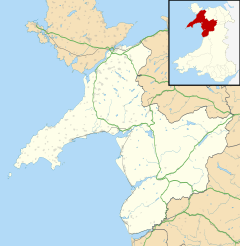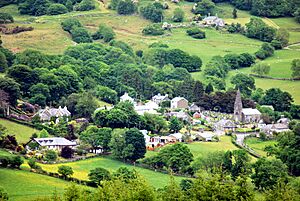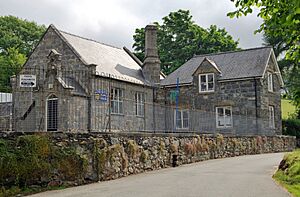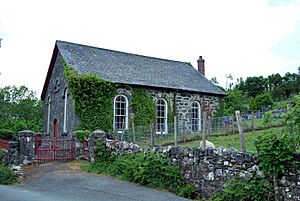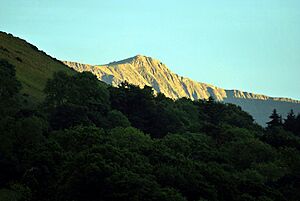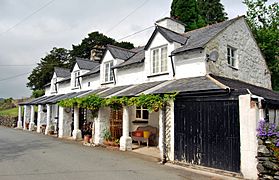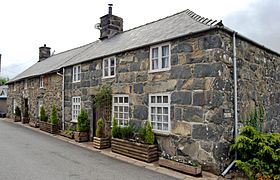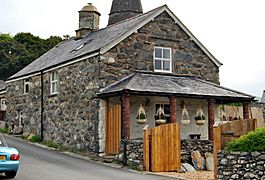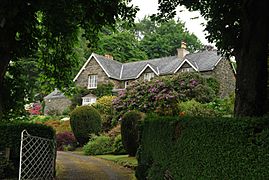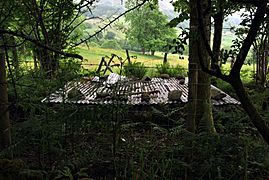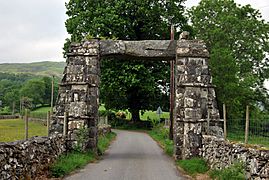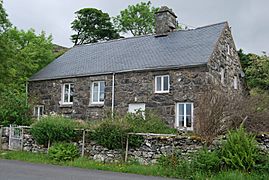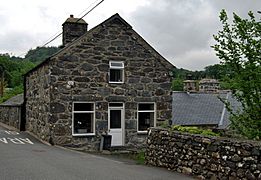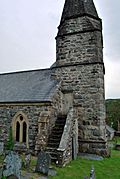Llanfachreth facts for kids
Quick facts for kids Llanfachreth |
|
|---|---|
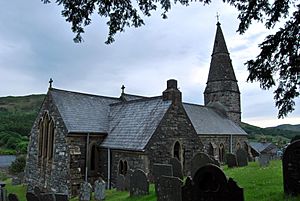 St. Machreth Church, Llanfachreth |
|
| Population | 200 (2001 census) |
| OS grid reference | SH755225 |
| Community |
|
| Principal area | |
| Ceremonial county | |
| Country | Wales |
| Sovereign state | United Kingdom |
| Post town | DOLGELLAU |
| Postcode district | LL40 |
| Dialling code | 01341 |
| Police | North Wales |
| Fire | North Wales |
| Ambulance | Welsh |
| EU Parliament | Wales |
| UK Parliament |
|
| Welsh Assembly |
|
Llanfachreth is a small village in Gwynedd, Wales. It's about three miles northeast of Dolgellau. The village is part of the Brithdir and Llanfachreth community. It sits in the beautiful historic area of Merionethshire.
Contents
Exploring Llanfachreth's Past
Llanfachreth is a small village in northwest Wales. A powerful local family, the Nannau family, greatly influenced its history. The village was mentioned in an old book called the Imperial Gazetteer of England and Wales in 1872. It described Llanfachreth as a village on the River Mawddach. It also mentioned local fairs held throughout the year.
The area around Llanfachreth has a very long history. People have lived here for thousands of years.
Ancient Discoveries
Archaeologists have found many old sites near Llanfachreth. One is a burial mound called 'Cors y Garnardd'. There are also remains of an ancient hill fort on a hill called Moel Offrwm. This name means 'Hill of Sacrifice'. Old stories say a local lord named Ophrom Gawr once lived there. Another old camp, 'Y Gaer', is located high up on a hill.
An Iron Age fort was found at 'Dol y Clochydd'. This name means 'the sexton's meadow'. Even older Bronze Age burial urns have been discovered in a stone chest. These finds show how important this area was long ago.
The Nannau Family's Impact
From the 12th century, two families, the Nanneys and the Vaughans, owned most of the land in Llanfachreth parish. Their estate was known as the Nannau estate. The village's history is closely tied to these families.
Cadwgan, a prince from the early 12th century, built Nannau house. This grand mansion is about a mile southwest of Llanfachreth. His family kept the land until 1701.
Robert Williams Vaughan was a very important figure. He was the second baronet and lived from 1768 to 1843. He managed the area for over 50 years. People called him "Yr Hen Syr Robert," meaning "Old Sir Robert." During his time, he rebuilt Nannau house. He also became a Member of Parliament for Merioneth.
Sir Robert did a lot for the area. He helped rebuild nearby Dolgellau. He also paid for new cottages, roads, and fences. He even created the famous Precipice Walk on his estate. Much of this work helped people find jobs after the Napoleonic wars. He built a striking arch called "Y Garreg Fawr" (the Great Stone). Many of the cottages he rebuilt in Llanfachreth have unique designs. They feature curved slate roofs and round brick pillars.
Life in the Village
Llanfachreth has several interesting features. Besides the church, there's a war memorial. It honors local people who died in the world wars. There's also an old mounting block. This stone block was once used to help people get onto horses. It also served as a meeting spot for important announcements.
The cottage "Ty-isa," across from the church, used to be a pub and brewery. Later, its brewing pot was used to dip sheep. Before the mid-1800s, education for children in the area was not very good. Parents, the church, or volunteers taught children.
The Village Church
The church in Llanfachreth is dedicated to St Machreth. People believe St Machreth came from Llanfachreth around the 5th century. There's a house nearby called 'Gell Fachreth', which means 'Machreth's Cell'. The church's foundations date back to the 15th century. A local lord helped pay for its building in 1494.
The church stayed the same for about 300 years. Then, Sir Robert Vaughan started making improvements in 1800. These changes took almost 30 years to finish. Inside the church, there is an inscription. It honors King George III and Sir Robert Vaughan's efforts.
The village has about 80 people, and nearby farms add about 150 more. This makes a total of 200 people. The church congregation is small, with fewer than a dozen regular members. Some of them come from other villages. In 1872, the church built by the 2nd baronet was taken down. A new church was built in its place. The Bishop of Bangor gave a sermon at its opening. The tower from the 19th-century church still stands today.
The church has memorials for the Nannau and Vaughan families. There is also a memorial for Rice Jones, a Welsh poet. The churchyard has four very old yew trees.
The Chapel
There were some disagreements about Methodism in the area. The local baronet did not allow Methodists to rent his properties. However, they found other homes to rent. In 1804, a new chapel was built. This provided a place for the Methodist congregation to worship.
Fun Things to Do Nearby
The area around Llanfachreth is famous for its beautiful countryside. It's a great place for tourists who love outdoor activities. You can enjoy walking, hiking, horse riding, white-water rafting, and climbing. Nearby Dolgellau is a popular starting point for climbers. They often climb Cadair Idris, a famous mountain.
There's also the Llwybr Mawddach, or "Mawddach Trail." This used to be a railway line. Now, it's a path for walkers and cyclists. It runs for about eight miles from Dolgellau to Morfa Mawddach. The Snowdonia National Park maintains the trail. It passes through areas important for water birds.
Other historical places to visit include the 12th-century Cymer Abbey. A mile west of Llanfachreth, you can find nature walks. There are also old copper mines to explore along the Mawddach river.
Llanfachreth is a good base for visiting several narrow-gauge heritage railways. These include the Corris Railway, the Fairbourne Railway, and the Talyllyn Railway. The Center for Alternative Technology is also about 20 miles south. The village is close to the center of Snowdonia National Park. This means easy access to the Precipice Walk and the Mawddach river valley. The views from the Precipice Walk are definitely worth seeing!
Famous People from Llanfachreth
- Rice Jones (1713–1801): He was a famous Welsh poet and historian. He was buried in St. Machreth church.
- William Williams of Wern (1781–1840): He was an important Independent minister in Wales.
- E. Gwyndaf Evans (1913–1986): He was a poet. He served as the Archdruid of the National Eisteddfod of Wales from 1966 to 1969.
Gallery


